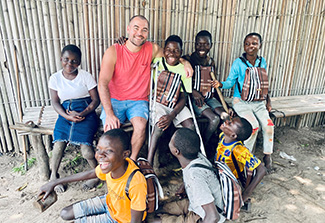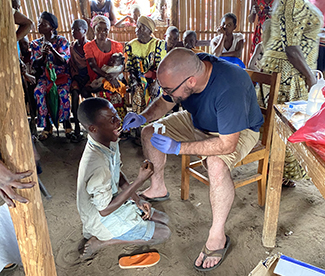A quest for molecular and agricultural solutions to prevent konzo
November / December 2022 | Volume 21 Number 6
 Photo courtesy of Matthew BrambleDr. Matthew Bramble spends time with the children of Kahemba. "You get to know the kids, and, well, the story changes. It's no longer just interesting science. "
Photo courtesy of Matthew BrambleDr. Matthew Bramble spends time with the children of Kahemba. "You get to know the kids, and, well, the story changes. It's no longer just interesting science. "
By Susan Scutti
While working on an Ebola project in the Democratic Republic of Congo (DRC), Dr. Matthew Bramble—a staff scientist at Children's National Medical Center—met
Dr. Desire Tshala, who convinced him to work on konzo, a disease he'd never heard of. Over the next two years, Bramble helped analyze data collected by Tshala's team without once meeting anyone affected by the disease. Eventually, Bramble found time to make the long trek to Kahemba. “You get to know the kids, and, well, the story changes. It's no longer just interesting science. Now I'd like to solve it."
Bramble's Fogarty-funded project aims to reveal connections between konzo and the gut microbiome—the trillions of bacteria and other microbes living in our gastrointestinal tracts. The human body cannot metabolize linamarin (a toxic, cyanide-related chemical in cassava), so it eliminates it instead. "If linamarin is going through you, it's still got to be acted on by intestinal microflora,” explained Bramble. The gut microbiome, then, may play a significant role in konzo's genesis.
Big data applications
In Kahemba, there are many households where one sibling gets konzo but another doesn't, despite sharing the same lifestyle and food, said Bramble. “Why that exists we still don't know." To find answers, his team assembled a hundred sibling pairs—one hundred konzo-affected children plus a hundred unaffected siblings—collected samples, and then performed 50 million DNA reads. “Essentially, we've done the most comprehensive 'omics' possible on these children, including meta-transcriptomics to see which genes are expressed and which not expressed.” Data analysis is not yet complete, but early findings have shown “some very interesting metabolic differences between affected and unaffected children."
 Photo courtesy of Matthew BrambleBramble uses a swab to take samples from a child in Kahemba. His team collected samples from one hundred konzo-affected children plus a hundred unaffected siblings to answer why some children get the disease but others do not.
Photo courtesy of Matthew BrambleBramble uses a swab to take samples from a child in Kahemba. His team collected samples from one hundred konzo-affected children plus a hundred unaffected siblings to answer why some children get the disease but others do not.
Neerja Vashist, co-author and a graduate student researcher in the Department of Genomics and Precision Medicine at George Washington University, said they knew a “big data component" would be needed to answer the most pressing questions about konzo. “Big data allows you to get a lot of information out, and the data we get from the gut microbiome can possibly be applied, in a laboratory setting, to test other hypotheses." The work is not easy, she said. “We may collect samples even if we might not have the funds to do the research right away, so we also need to plan the biobanking."
Historically, the villagers have seen konzo as random and sporadic, said Bramble. “But I don't think it's either. There is a variable enabling this to happen to some but not all the kids. This is what the newest konzo research is trying to identify." Bramble noted that outbreaks of konzo always follow an environmental stressor that interferes with the processing of cassava. “After the dry season, you can be certain that there's going to be, say, 5% or so of a village that will be paralyzed." He hopes his research elucidates the factors determining which children are affected. “We have the statistical power to also start looking at the differences between 'mild' disease—certainly it's not mild by any standard—versus having to crawl around on all fours."
Introducing a new strain
It's likely that not all answers will be found in hard molecular science, said Bramble, who also conducts research in the Philippines. There, he discussed konzo with Professor Vivian Topor, an agricultural expert. “Over her 30-year career, she's bred various strains of cassava and, based on the color, you can estimate the cyanide content in some varieties." He plans to introduce cassava from the Philippines to DRC, monitoring the crop to see how it behaves. “Cassava toxicity is very dependent on the environment. So poor soil and/or low water can make the plant more poisonous, but this new strain doesn't fluctuate nearly as much as others."
Additional cassava connections may be found in India, added Vashist who won a Fulbright to work there. Cassava is consumed in India (though not usually as a staple) and one case study identified a phenotype similar to konzo in the state of Kerala. “They call it tropical ataxia neuropathy or TAN," she explained. “The affected age group and actual specifics are a little different, but cassava toxicity is the common factor between the two conditions."
An agricultural solution to prevent konzo “inherently makes sense," said Vashist. “Change the crop, fix the problem permanently." Yet, research conducted by Tshala, Cliff, and others show proven benefits when using the wetting method and nutritional rehabilitation. Until scientists gather evidence-based results for a new crop-swap solution, these older methods may best protect the children against konzo.
“People tell me, 'Since Tshala's been in town, we've seen less cases of konzo'," said Vashist. Mothers just need to understand that the wetting method makes food safer. “Food is so personal and it's what you eat every day. Mom's want it to be the best."
More Information
Updated December 15, 2022
To view Adobe PDF files,
download current, free accessible plug-ins from Adobe's website.
Related Fogarty Programs
Related World Regions / Countries
Related Global Health Research Topics